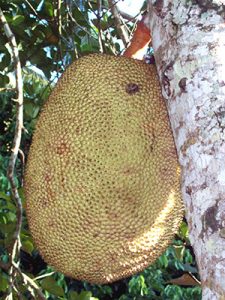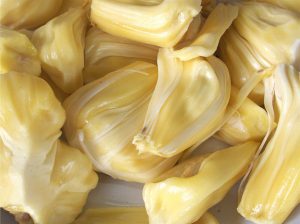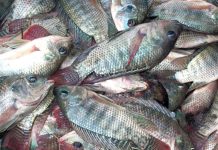 “The world has always been like this: one man feasts on the jackfruit and the other gets stuck in the sap,” says a familiar saying. Another one goes like this, “Whoever eats the jackfruit, will be touched by the sap.”
“The world has always been like this: one man feasts on the jackfruit and the other gets stuck in the sap,” says a familiar saying. Another one goes like this, “Whoever eats the jackfruit, will be touched by the sap.”
The fruit is called a variety of names around the world. The English one, jackfruit, is generally cited as deriving from the Malayalam chakka or cakkai via the Portuguesejaca, the name for it used by the physician and naturalist Garcia de Orta in his 1563 book. However, a botanist named Ralph Randles Stewart argued that it was named after William Jack (1795-1822), a Scottish botanist who worked for the East India Company in Bengal, Sumatra and Malaysia .
Like most tropical fruits, Westerners considered jackfruit as somewhat weird and exotic. It is enormous and prickly on the outside and it looks somewhat like the controversial durian (although it tastes like heaven, it smells like hell).
Once a jackfruit is cracked open, what you will find inside are pods or “bulbs.” Often referred to as the seeds, these bulbs are actually the fleshy covering for the true seeds or pits, which are round and dark like chestnuts. The fruit juices are extremely sticky, so people often oil their hands before preparing the fruit.
Actually, the “bulbs” are delicious raw or as ice cream, jelly, chutney, syrup and jam. An American journalist describes jackfruit in these words: “The ripe fruit smells like rotting onions from the outside, but the fruit flesh inside smells like banana or pineapple.”
Nutritionists claim the fruit is nearly as calorie-dense as the custard apple. Hundred grams of the edible flesh, including the seeds, contains almost 100 calories, most of it as sugar and starch. The flesh is rich in beta-carotene and potassium, while the seeds are rich in thiamine and riboflavin-B vitamins.
The young fruit is also a vegetable. The cuisines of Bangladesh , Indonesia , In dia ,the Philippines , Sri Lanka , and Vietnam use cooked young jackfruit. In many cultures, jackfruit is boiled and used in curries as a food staple.
Here’s a word of warning: Eating uncooked, unripe fruit can cause indigestion; the culprit is an enzyme that inhibits the gut’s protein-digesting enzyme called trypsin. However, cooking destroys this inhibitor. On the other hand, the ripe fruit increases gut motility and can cause diarrhea among those who eat too much of the fruit.
 There’s more to jackfruit. The pulp, when boiled in milk, yields delicious orange-toned custard, while frying dry, salted bulbs serves up an alternative to potato chips. Jackfruit seeds (nuts) can be roasted like chestnuts, or boiled. If left to cook inside the flesh (for example, in curries or other cooked dishes), the nut softens and can easily be eaten.
There’s more to jackfruit. The pulp, when boiled in milk, yields delicious orange-toned custard, while frying dry, salted bulbs serves up an alternative to potato chips. Jackfruit seeds (nuts) can be roasted like chestnuts, or boiled. If left to cook inside the flesh (for example, in curries or other cooked dishes), the nut softens and can easily be eaten.
Jackfruit also possesses some medicinal properties. The Chinese consider jackfruit pulp and seeds tonic, cooling and nutritious, and to be “useful in overcoming the influence of alcohol on the system.” The seed starch is given to relieve biliousness and the roasted seeds are regarded as aphrodisiac. The ash of jackfruit leaves, burned with corn and coconut shells, is used alone or mixed with coconut oil to heal ulcers.
There are also reports that the latex, when mixed with vinegar, promotes healing of abscesses, snakebite and glandular swellings. The root is a remedy for skin diseases and asthma. An extract of the root is taken in cases of fever and diarrhea. The bark is made into poultices. Heated leaves are placed on wounds. The wood has a sedative property; its pith is said to produce abortion.
Recent laboratory studies show that lectins found in jackfruit and its seeds may have antibacterial, antifungal, antiviral, and immunostimulative properties. However, clinical study is still lacking. The currently available research examines the role of jackfruit leaves in increasing glucose tolerance. More studies in humans are needed to define jackfruit’s potential role in diabetes.
In agriculture, jackfruit is also indispensable. In some areas, the jackfruit is fed to cattle. The tree is even planted in pastures so that the animals can avail themselves of the fallen fruits. Surplus jackfruit rind is considered a good stock food.
Jackfruit is also good in controlling pests. The golden apple snail is one of the major rice pests in Asia, including the Philippines . If they are not controlled, they can devastate the rice crops causing huge losses to farmers. In Malaysia , some farmers are using jackfruit instead of pesticides to control the snails. They put rotten jackfruits in their rice fields.
This is how they do it. Fresh rotten jackfruits with strong smell are collected. These are carefully place in a suitable spot with running water and populated with golden snails as bait and should not be submerged under water. The bait is left overnight and in the morning, snails that gather on and around the jackfruit are collected and destroyed. The rotten jackfruit may be replaced if and when necessary.
Here are more other uses of jackfruit:
Latex: The heated latex is employed as household cement for mending chinaware and earthenware, and to caulk boats and holes in buckets. Although it could be used as a substitute for rubber, the latex contains 82.6 to 86.4% resins which may have value in varnishes.
Wood: Its wood changes with age from orange or yellow to brown or dark-red. It is termite-proof, fairly resistant to fungal and bacterial decay, and resembles mahogany. It is superior to teak for furniture, construction, turnery, masts, oars, implements, brush backs and musical instruments. In Cebu , guitars made from the wood of jackfruit are very popular. Though sharp tools are needed to achieve a smooth surface, it polishes beautifully. Roots of old trees are greatly prized for carving and picture framing.
From the sawdust of its wood or chips of the heartwood, boiled with alum, there is derived a rich yellow dye commonly used for dyeing silk and the cotton robes of Buddhist priests. In Indonesia , splinters of the wood are put into the bamboo tubes collecting coconut toddy in order to impart a yellow tone to the sugar.
Bark: There is only 3.3% tannin in the bark which is occasionally made into cordage or cloth.
Jackfruit (scientific name: Artocarpus heterophyllus) is native to southwestern India and Sri Lanka . It was reportedly cultivated for food as early as the 6th century BC in India . At approximately 25 centimeters in diameter, jackfruit is reportedly the largest tree-borne fruit in the world.






